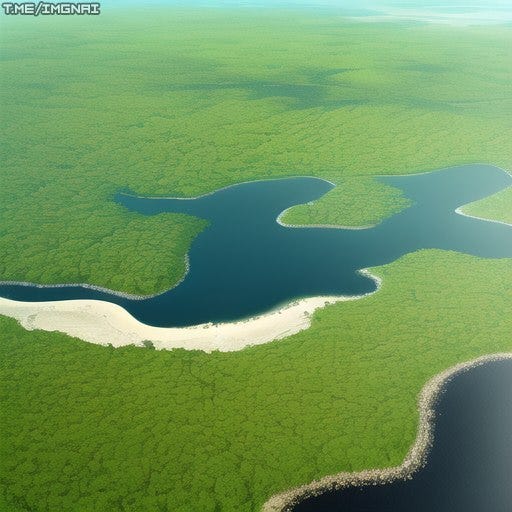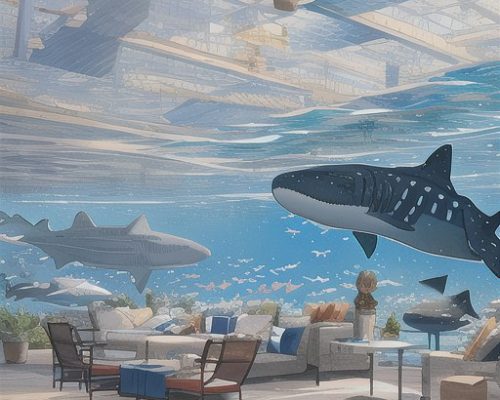
Mangrove lagoons are unique and important ecosystems that are often overlooked in comparison to other coastal habitats like coral reefs or wetlands. But despite their seemingly unassuming appearance, mangrove lagoons are teeming with life, play a vital role in maintaining the health of the planet and have many benefits for humanity. In this article, we’ll dive into the fascinating world of mangrove lagoons, exploring their biology, the role they play in the ecosystem, the value they hold for economies, their conservation and much more.
Biology of Mangrove Lagoons
Mangrove lagoons are typically found along tropical and subtropical coastlines and are characterized by their complex network of channels and shallow waters. These habitats are dominated by mangrove trees and shrubs, which have evolved to thrive in the harsh conditions of these areas. The roots of these trees act as natural filters, removing pollutants and excess nutrients from the water and providing a home for a diverse range of species.
Mangrove lagoons are also a critical habitat for many species of fish, shellfish, and crustaceans, which are important sources of food for larger predators, including birds and marine mammals. The shallow waters of mangrove lagoons also provide crucial nursery habitats for juvenile fish and crustaceans, which use the protection offered by the dense mangrove roots to avoid predators and grow to maturity.
The Role of Mangrove Lagoons in the Ecosystem
Mangrove lagoons play a crucial role in the ecosystem by providing important habitats for a wide range of species and helping to maintain the health of the surrounding coastal environment. They act as a natural buffer against the impacts of storms and tidal surges, reducing the risk of damage to coastal communities and infrastructure. Mangrove lagoons also help to improve water quality by removing pollutants and excess nutrients from the water and reducing the risk of harmful algal blooms.
Mangrove lagoons are also important carbon sinks, storing vast amounts of carbon in their biomass and soils. This helps to mitigate the impacts of climate change and provides valuable ecosystem services, such as reducing the risk of coastal flooding and protecting shorelines from erosion.
The Economic Value of Mangrove Lagoons
Mangrove lagoons provide a range of valuable services to human communities, including supporting local livelihoods and providing important economic benefits. For example, mangrove forests are an important source of wood and other forest products, and they also provide valuable habitats for important fishery resources, such as shrimp and fish.
Mangrove lagoons are also valuable tourism destinations, attracting visitors who are interested in exploring these unique habitats and the diverse range of wildlife they support. In many countries, mangrove lagoons have been developed into ecotourism destinations, providing local communities with new income streams and helping to support conservation efforts.
Conservation and the Future of Mangrove Lagoons
Despite their importance, mangrove lagoons are under threat from a range of human activities, including deforestation, conversion to agriculture, and urban development. Climate change is also a major threat to these ecosystems, with rising sea levels and increased frequency of storms and tidal surges putting the future of mangrove lagoons at risk.
To ensure the survival of these vital ecosystems, it is essential that we take action to protect and conserve mangrove lagoons.
The Future and Preservation of Mangrove Lagoons
As our understanding of the crucial role that mangrove lagoons play in our ecosystem continues to grow, it becomes increasingly important to preserve and protect these valuable habitats. With the destruction of mangrove forests estimated to be occurring at a rate of 1% per year, the urgency to take action to conserve these ecosystems is clear. Efforts to protect and restore mangrove lagoons include creating protected areas, reducing pollution and other negative human impacts, and promoting sustainable use and management of these ecosystems.
Additionally, continued research into the unique features and benefits of mangrove lagoons can lead to new and innovative ways to utilize these habitats in a sustainable manner. For example, the study of chinampas and the similarities they share with mangrove lagoons has the potential to lead to the development of new systems for food production and water management.
Ultimately, the preservation of mangrove lagoons is essential not just for the diverse range of species that call these habitats home, but for the well-being and survival of humanity itself. As we continue to learn more about the important role these ecosystems play in regulating our climate, protecting our coastlines, and providing valuable resources, it becomes clear that investing in their conservation is not just a moral obligation, but a critical necessity.
In conclusion, mangrove lagoons are vital ecosystems that play a crucial role in maintaining the delicate balance of our planet. They serve as important habitats for a diverse range of species, protect our coastlines from natural disasters, support local economies, and provide numerous benefits to human communities. As the threat of climate change and other environmental challenges loom, it is essential that we prioritize the conservation and preservation of these ecosystems. From protecting coastlines and providing habitats for diverse species, to supporting sustainable development and helping mitigate the effects of climate change, mangrove lagoons are truly valuable habitats that should not be overlooked. By working together, and investing in research and conservation efforts, we can ensure that these unique environments are preserved for future generations to enjoy and benefit from.

CWS is an experimental nft crypto defi game project built around the concept of marine ecosystems. CWS aims to create a sustainable and community-driven ecosystem for its users. The project allows active users to earn token rewards through token staking, NFT ownership, and more.
DISCLAIMER: This paper and the information contained within it were generated by an Artificial Intelligence (AI) model, and as such, may contain inaccuracies or be incorrect. It is the reader’s responsibility to conduct their own research and make their own decisions based on the information presented. The information contained in this paper should not be construed as financial advice. The authors and/or publishers of this paper assume no responsibility for any errors or omissions and shall not be held liable for any loss or damage of any kind arising from the use of the information contained within. The reader assumes full responsibility for any actions they take based on the information contained in this paper. This paper is provided for educational and informational purposes only and is not intended to be investment advice. Please be aware that the use of AI technology may result in unexpected outcomes. The authors and/or publishers of this paper make no representations or warranties of any kind, express or implied, about the completeness, accuracy, reliability, suitability or availability with respect to the information, products, services, or related graphics contained in this paper for any purpose. Any reliance placed on such information is strictly at your own risk.


